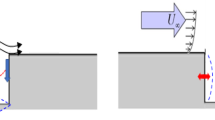Abstract
Unlike the steady closed-type supersonic cavity flow, open-type cavity flow is divided into internal and external flows by turbulent shear layer. The cavity flow may cause resonance phenomena due to pressure oscillation, depending on the cavity geometry and the flow conditions. These phenomena may induce noise generation, structural damage, and aerodynamic instability. In this research, the flow characteristics of three-dimensional supersonic cavity flow of Mach number 1.5 were analyzed with the variations of aspect ratio and width ratio. Three-dimensional unsteady compressible Reynolds-averaged Navier-Stokes (RANS) equations were used with a turbulence model. For numerical calculations, the 4th-order Runge-Kutta method and the FVS method with van Leer’s flux limiter were applied. The numerical calculations were performed by using a parallel processing program with 16 CPUs. The sound pressure level (SPL) spectra of pressure variations were analyzed at the point of cavity leading edge. The correlation of pressure distribution (CPD) was also analyzed for the propagation of dominant oscillation pressure waves with respect to the reference point of the cavity leading edge. The dominant oscillation frequency was compared with the oscillation modes of Rossiter’s formula. Oscillation Mode 2 appeared as a dominant oscillation frequency regardless of the aspect ratio of cavity in the two-dimensional flow. Oscillation Modes1 and 2 appeared in three-dimensional cavities of small aspect ratios. However, as the aspect or the width ratio increases, only the mode 2 or 3 frequency appeared as a dominant oscillation frequency.
Similar content being viewed by others
References
X. Zhang and J. A. Edwards, Analysis of unsteady supersonic cavity flow employing an adaptive meshing refinement algorithm, Computers & Fluids, 25(4) (1996) 373–393.
D. J. Maull and L. F. East, Three-dimensional flow in cavities, J. Fluid Mechanics, 16 (1963) 620–632.
K. Krishnamurty, Acoustic radiation from two-dimensional rectangular cutouts in aerodynamic surfaces, NACA TN-3487 (1955).
J. E. Rossiter, Wind-tunnel experiments on the flow over rectangular cavities at subsonic and transonic speeds, Aeronautical Research Council Reports and Memoranda 3438 (1964).
H. H. Heller, D. G. Holmes and E. E. Covert, Flow-induced pressure oscillations in shallow cavities, Journal of Sound and Vibration, 18 (1971) 545–553.
C. W. Rowley, T. Colonius and A. J. Basu, On self-sustained oscillations in two dimensional compressible flow over rectangular cavities, J. Fluid Mech., 455 (2002) 315–346.
M. Sinha, B. J. York and S. M. Dash, Chidambaram, N., A Perspective on the Simulation of Cavity Aeroacoustics, AIAA-98-0286 (1998).
M. Gharib and A. Roshko, The effect of flow oscillations on cavity drag, J. Fluid Mechanics, 177 (1987) 501–530.
M. S. Chingwei and J. M. Philip, Comparison of Two-and Three-Dimensional Turbulent Cavity Flows, AIAA A01-16385 (2001).
Woo, Kim and Lee, Analysis of two dimensional and three dimensional supersonic turbulence flow around tandem cavities, KSME Int. J., 20(8) (2006) 1256–1265.
X. Zhang and J. A. Edwards, Experimental investigation of supersonic flow over two cavities in tandem, AIAA J. 30(5) (1992) 1182–1190.
K. C. Hoffmann and S. T. Chiang, Computational Fluid Dynamics for Engineers, Engineering Education System USA, (1993).
D. C. Wilcox, Reassessment of the scale determining equation for advanced turbulence models, AIAA J. 19(2) (1988) 248–251.
S. P. Pao and K. S. Abdol-Hamid, Numerical Simulation of Jet Aerodynamics Using the Three-Dimensional Navier-Stokes Code PAB3D, NASA TP 3596 (1996).
J. E. Bardina, P. G. Huang and T. J. Coakley, Turbulence Modeling Validation, Testing, and Development, NASA TM 110446 (1997).
C. S. Abdol-Hamid, B. Lakshmanan and J. R. Carlson, Application of Navier-Stokes Code PAB3D with Turbulence Model to Attached and Separated Flows, NASA TP 3480 (1975).
D. E. Newland, An Introduction to Random Vibrations, Spectral and Wavelet Analysis, Longman Press, Third edition (1993).
Author information
Authors and Affiliations
Corresponding author
Rights and permissions
About this article
Cite this article
Woo, Ch., Kim, Js. & Lee, Kh. Three-dimensional effects of supersonic cavity flow due to the variation of cavity aspect and width ratios. J Mech Sci Technol 22, 590–598 (2008). https://doi.org/10.1007/s12206-007-1103-9
Received:
Revised:
Accepted:
Published:
Issue Date:
DOI: https://doi.org/10.1007/s12206-007-1103-9




